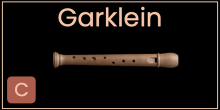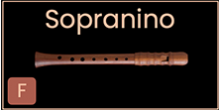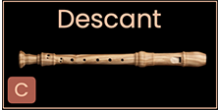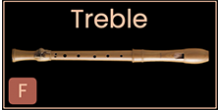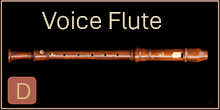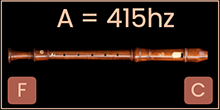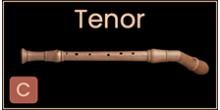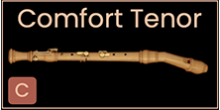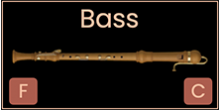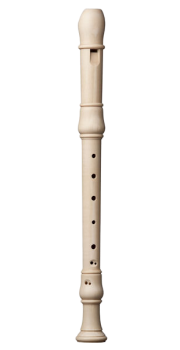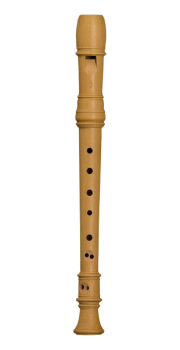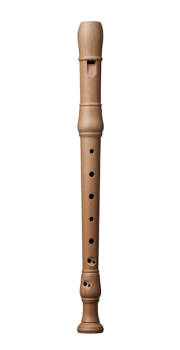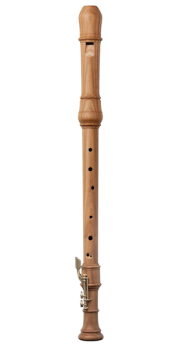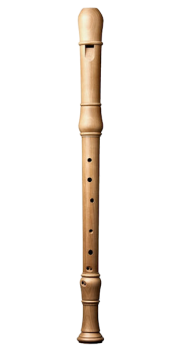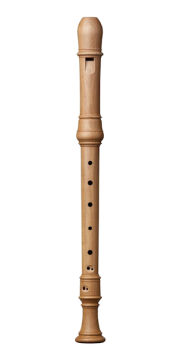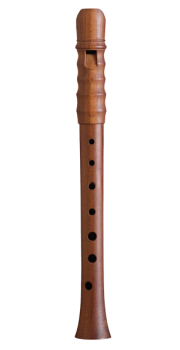No products
Prices are tax included
Filters
Recorders are made in different sizes with names and compasses roughly corresponding to different vocal ranges. The sizes most commonly in use today are the soprano ("descant", lowest note C5), alto "treble", lowest note F4), tenor (lowest note C4) and bass (lowest note F3). Recorders are traditionally constructed from wood and ivory, and now c...
Recorders are made in different sizes with names and compasses roughly corresponding to different vocal ranges. The sizes most commonly in use today are the soprano ("descant", lowest note C5), alto "treble", lowest note F4), tenor (lowest note C4) and bass (lowest note F3). Recorders are traditionally constructed from wood and ivory, and now come in a wide range of different woods. Recorders are also made in plastic and you can buy beginner as well as high quality plastic recorders. The recorders' internal and external proportions vary, but the bore is generally reverse conical (i.e. tapering towards the foot) to cylindrical, and all recorder fingering systems make extensive use of cross fingering.
Today, recorder sizes are named after the different vocal ranges. This is not, however, a reflection of sounding pitch, and serves primarily to denote the pitch relationships between the different instruments. Groups of recorders played together are referred to as "consorts." Recorders are also often referred to by their lowest sounding note: "recorder in F" refers to a recorder with lowest note F, in any octave.
The recorder is used as an ensemble or consort instrument and comes in a variety of different woods including, pear, maple, plum, palisander, rosewood, olivewood, grenadilla, satinwood and cherrywood.
Orpheus Music is a Recorder specialist shop. A large range of quality recorders from Mollenhauer, Kung, Dolmetsch, Aulos, Zen-on and Kunath Peatzold. Garklein recorders, descant recorders, soprano recorders, treble recorders, alto recorders, tenor, bass recorders, and great bass recorders. Many different models including Kung studio, Kung Superio, Kung Marsayas, Mollenhauer Canta, Mollenhauer Denner range, Mollenhauer dream. Also a large range of recorder accessories including cases, thumbrests, straps, stands, oils, cork grease, cleaning rods and brushes.
The recorder is first documented in Europe in the Middle Ages, and continued to enjoy wide popularity in the renaissance and baroque periods, but was little used in the classical and romantic periods. It was revived in the 20th century as part of the historically informed performance movement, and became a popular amateur and educational instrument. Composers who have written for the recorder include Monteverdi, Lully, Purcell, Handel, Vivaldi, Telemann, Johann Sebastian Bach, Paul Hindemith, Benjamin Britten, Leonard Bernstein, Luciano Berio, and Arvo Pärt. Today, there are many professional recorder players who demonstrate the instrument's full solo range and a large community of amateurs.
The sound of the recorder is often described as clear and sweet, and has historically been associated with birds and shepherds. It is notable for its quick response and its corresponding ability to produce a wide variety of articulations. This ability, coupled with its open finger holes, allow it to produce a wide variety of tone colors and special effects. Acoustically, its tone is relatively pure and odd harmonics predominate in its sound.
Subcategories
Garklein recorders are the smallest in the family of recorders. Orpheus Music stocks Garklein recorders from Mollenhauer Recorders and Kung Recorders. They are made in plastic, pearwood, maple and plum woods. The Garklein is half the size of a descant recorder (soprano recorder). It is sometimes used in consort playing and Recorder Orchestra repertoire.
The Sopranino recorder is the second smallest in the recorder family. Orpheus Music stocks sopranino recorders from a variety of makers including Mollenhauer Recorders from Germany, Kung Recorders from Switzerland, Dolmetch Recorders from England, and Aulos Recorders from Japan. Wooden Sopraninos are made from a variety of woods including pear, plum, olive, palisander, grenadilla, boxwood. The sopranino recorder was traditionally used to teach birds to sing and adds the very high sounds to ensemble or consort.
Descant recorders also referred to soprano recorders, are the third member of the recorder family. Orpheus Music stocks a large range of descant recorders, from a variety of makers including Mollenhauer Recorders from Germany, Kung Recorders from Switzerland, Dolmetsch Recorders from England, and Aulos Recorders and Zen-on Recorders from Japan. Beautiful wooden recorders come in a different variety of woods using pear, plum, satinwood, olive, rose, palisander, grenadilla, boxwood and cherrywood. The descant recorder traditionally is used to teach children music but is a wonderful instrument in its own right. In consorts it is usually has the melody line, but has some beautiful soloistic music written for it, some of the classic repertoire for the descant recorder includes Jacob van Eyck "Der Flutyen Lust-Hoft".
The treble or alto recorder is the most popular instrument of the recorder family, with much of the solo repertoire composed for its range. Orpheus Music stocks a large variety of treble/alto recorders from a variety of makers including Mollenhauer Recorders from Germany, Kung Recorders from Switzerland, Dolmetsch Recorders from England, and Aulos Recorders and Zen-on Recorders from Japan. High-quality plastic and wooden alto recorders are available and come in many different varieties of woods - such as pear, plum, satinwood, olive, rose, palisander, grenadilla, boxwood and cherrywood. The treble recorder is a F instrument, in consorts the treble is either the melody line or harmony and is an ideal instrument for an adult to begin their recorder journey on.
Voice Flute
The Voice Flute is essentially a tenor recorder, but with the lowest note tuned to D instead of the tenor’s C. It was created in the Baroque period to give recorder players easier access to the flute’s repertoire. By tuning the voice flute in D, it is possible to play much of the Baroque Flute repertoire without transcription. The voice flute is constructed exactly like a tenor recorder, except the voicing is a little different. The particular voicing is used in order to accentuate the more flute-like aspects of the recorder sound. This is also supported by the use of softer woods in the construction.
Baroque A=415 Hz Descant and Treble Recorders
Explore our range of Descant and Treble Recorders tuned to A=415 Hz. This lower tuning is considered the standard for Baroque repertoire, and Orpheus Music stocks a range of beautiful Recorders from Mollenhauer, as well as a brand new a=415 Hz treble from Zen-on, which brings affordable Baroque tuning in a treble recorder for the first time.
Please read all of this before buying a tenor!!!
Many players find it difficult to reach all the holes when playing tenor, especially for the smallest 2 fingers of the right hand. The tenor is by no means the largest recorder, but still it can involve finger stretches greater than on any of the larger bass instruments. Our experience over 25 years has shown that when a player encounters finger spacing problems, ninety nine times out of a hundred it will be on a tenor. These problems often result in either having to stop playing the tenor altogether, or having to upgrade to a knick or a comfort model - please choose carefully!!!
There is quite a bit of variation in finger hole position from one maker to another, and from one model to another. The chart below was prepared to try and show which ones will be easier. There are several factors involved: the distance between the holes is important, but another significant factor is whether the recorder is straight or has a bent head ("knick"). Knick tenors allow the right hand to hold the recorder in a higher position than with a straight instrument - the right hand is not stretching down so far and consequently a spacing that may actually be a little wider will still feel easier to reach on a knick instrument. Players that have problems with their right-hand wrist should strongly consider knick instruments.
The chart shows clearly that the use of split keys for C and C# doesn't automatically mean the right-hand little finger doesn't have to stretch so far. Many players assume that if they choose a model with C/C# keys they will have no problems, when in fact many of the most extreme little-finger stretches are actually on keyed instruments.
Often a player will have specific issues with one or two fingers. If this is the case, then you may need to focus more on comparing the measurements for the holes played by the problem fingers. In such cases the general ranking provided here might not be so relevant for your special circumstances.
In this chart the weights shown are a guide only - weight can vary within a particular model depending on which wood has been used.

A large range of tenor recorders made in a beautiful range of woods including pear, plum, satinwood, olive, rose, palisander, grenadilla, boxwood and cherrywood. Orpheus Music stocks tenor recorders from a variety of makers including Mollenhauer Recorders from Germany, Kung Recorders from Switzerland and Aulos, Yamaha and Zen-on Recorders from Japan. The tenor is a great ensemble instrument as well as a favoured recorder for contemporary compositions.
Comfort Tenor Recorders
Browse our range of high quality comfort tenor recorders. A Comfort tenor recorder makes playing easy: two additional keys reduce the stretch of the hand.
Also available as a Knick tenor, getting the instrument even closer to the body and thus relieving stress on the arms.G-key
The left ring finger no longer needs to be strained.
F-key
The right index finger
C/C#-double key
The ergonomically designed and easy to operate key mechanism relieves the little finger of any strain when playing the lowest notes.
The tenor is the ideal instrument for anyone who already plays the soprano recorder but loves a warmer, deeper recorder sound.
You don’t have to relearn anything: the fingerings and notation are identical to that of the soprano recorder.Orpheus Music offers Bass recorders, great basses, contra and subcontra basses, including Baroque and Renaissance models. Bass recorders are made from pear and cherrywood. Orpheus Music stocks bass recorders from Mollenhauer Recorders from Germany, Kung Recorders from Switzerland, Aulos, Yamaha and Zen-on Recorders from Japan. The bass recorder is traditionally the bass part in an ensemble or consort of recorder players but now has many new compositions written for it. The bass recorder comes in plastic as well as wood in a straight neck form as well as a bent neck form. The traditional bass recorder is in F but there are larger and deeper basses including a great bass recorder in C, a contra bass in F (an octave below the first bass recorder).
Reference: K1402
Brand: Kung
Studio Treble Recorder in Maple
- Made from selected Maple.
- Baroque double holes.
- Suitable for beginners as well as for ensemble playing.
- The Kung Studio model recorders have a warm and pleasant sound.Â
$492.00In StockReference: MOL-5022
Brand: Mollenhauer
Denner Sopranino Recorder in Castello Boxwood
- Made from selected Castello Boxwood with Baroque double holes.
- Based on original instruments by Jacob Denner (1681-1735) in Nuremberg and Copenhagen.
- Reliable, accurate playing even in the highest register.
- A versatile, clear and beautiful sounding instrument.
$485.00In StockReference: K1301
Brand: Kung
Studio Descant Recorder in Pearwood
- Made from selected Pearwood.
- Baroque double holes.
- Suitable for beginners as well as for ensemble playing.
- The Kung Studio model recorders have a warm and pleasant sound.
$178.00In StockReference: K2503
Brand: Kung
Superio Tenor Recorder in Cherry
- Made from selected Cherry.
- Baroque double holes.
- This is a solo instrument par excellence, also outstanding in ensemble playing.
- Elegant Baroque styling.
- The wide range and rich sound allows selected flute repertoire to be played.
- The Cherry Superior has an elegant and clear sound.
$1,845.80In StockReference: MOL-4007
Brand: Mollenhauer
Kynseker Sopranino Recorder in Maple
- Maple dark stained Sopranino.
- Versatile instruments after Hieronymus F. Kynseker based on the original instruments kept at the Germanic National Museum in Nuremberg.
- Our Kynseker ensemble instruments remain faithful to the most important characteristics of the originals: its outer form and its strong sound, so full of personality.
$745.00Out of stockReference: K1302
Brand: Kung
Studio Descant Recorder in Maple
- Made from selected Maple.
- Baroque double holes.
- Suitable for beginners as well as for ensemble playing.
- The Kung Studio model recorders have a warm and pleasant sound.
- Includes sturdy carry pouch and service card/fingering chart.
$154.09In StockReference: K2509
Brand: Kung
Superio Tenor Recorder in Olivewood
- Made from selected Olivewood.
- Baroque double holes.
- This is a solo instrument par excellence, also outstanding in ensemble playing.
- Elegant Baroque styling.
- The wide range and rich sound allows selected flute repertoire to be played.
- The Olivewood Superior has an elegant, clear and light sound.
$2,601.95Out of stockReference: K1403
Brand: Kung
Studio Treble Recorder in Cherry
- Made from selected Cherry.
- Baroque double holes.
- Suitable for beginners as well as for ensemble playing.
- Within the Studio range, the Cherry descant has the most elegant sound.
$556.92In StockReference: K1503
Brand: Kung
Studio Tenor Recorder in Cherry
- Made from selected Cherry.
- Baroque double holes.
- Suitable for beginners as well as for ensemble playing.
- Within the Studio range, the Cherry tenor has the most elegant sound.
$1,043.00In StockReference: K2401
Brand: Kung
Superio Treble Recorder in Pearwood
- Made from selected Pearwood.
- Baroque double holes.
- A strong sound for dynamic playing either in ensemble or solo.
- Elegant Baroque styling.
- The Pearwood Superior has an earthy and warm sound.
$884.32In StockReference: K1311
Brand: Kung
Studio Descant Recorder in Stained Pearwood
- Made from selected Pearwood (stained a dark red).
- Baroque double holes.
- Suitable for beginners as well as for ensemble playing.
- The Kung Studio model recorders have a warm and pleasant sound.
- Includes sturdy carry pouch and service card/fingering chart.
$167.86In StockReference: MOL-4008
Brand: Mollenhauer
Kynseker Sopranino Recorder in Plumwood
- Plumwood Sopranino.
- Versatile instruments after Hieronymus F. Kynseker, based on the original instruments kept at the Germanic National Museum in Nuremberg.
- Our Kynseker ensemble instruments remain faithful to the most important characteristics of the originals: its outer form and its strong sound, so full of personality.
$850.00In Stock

